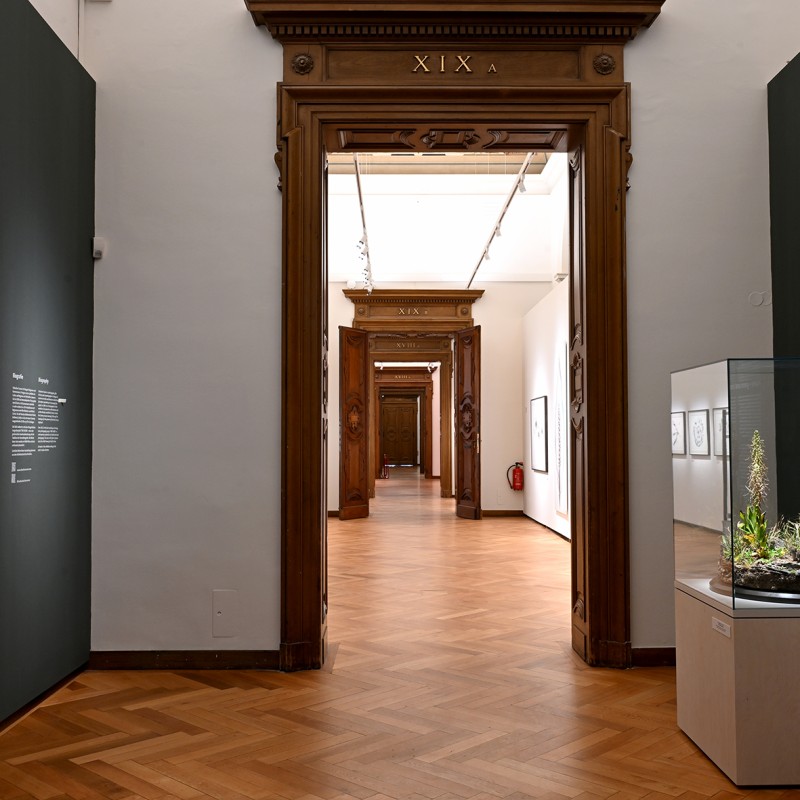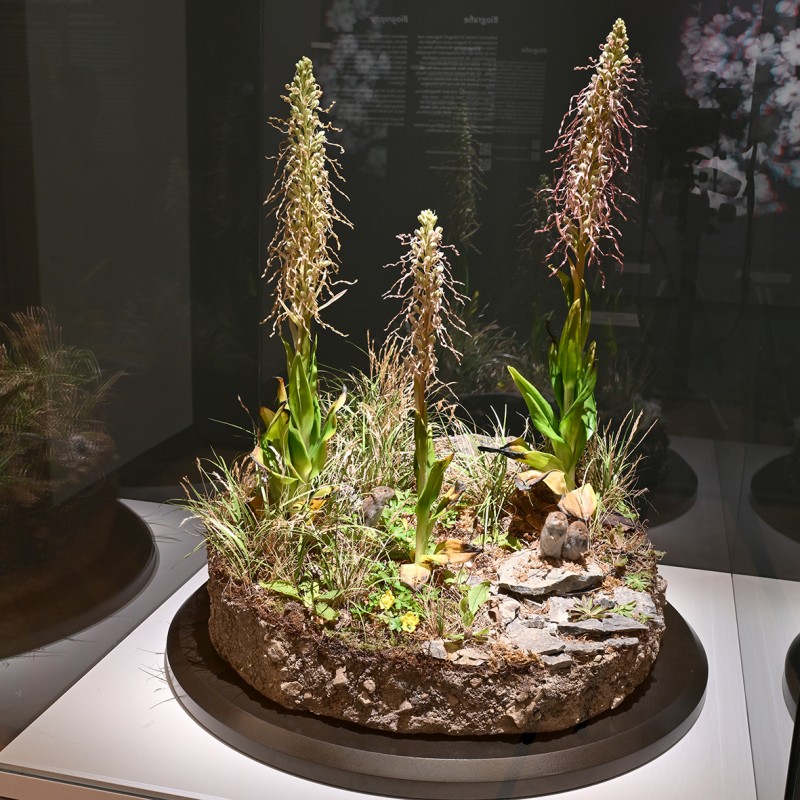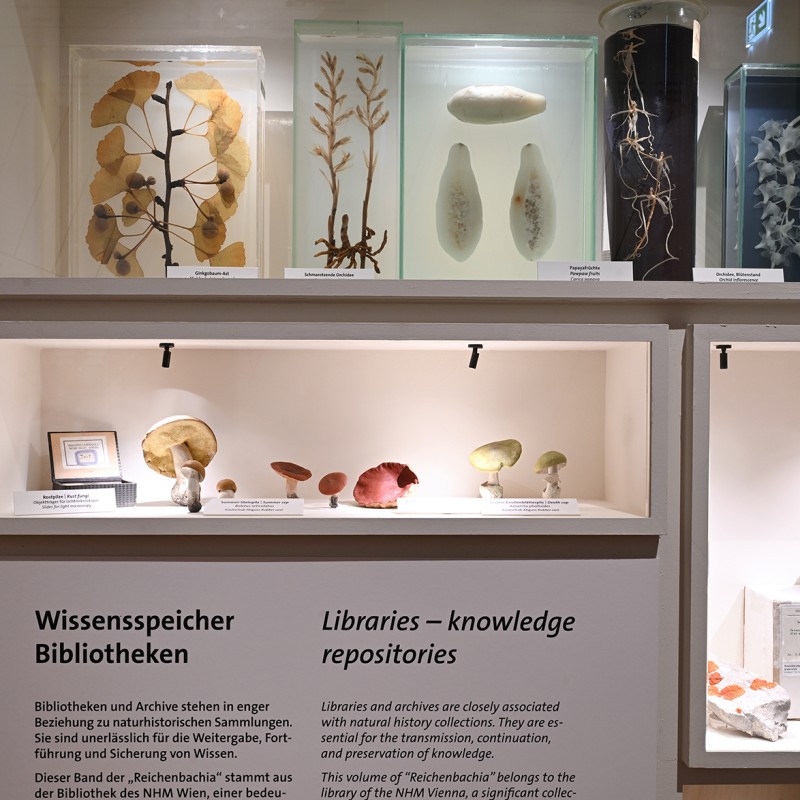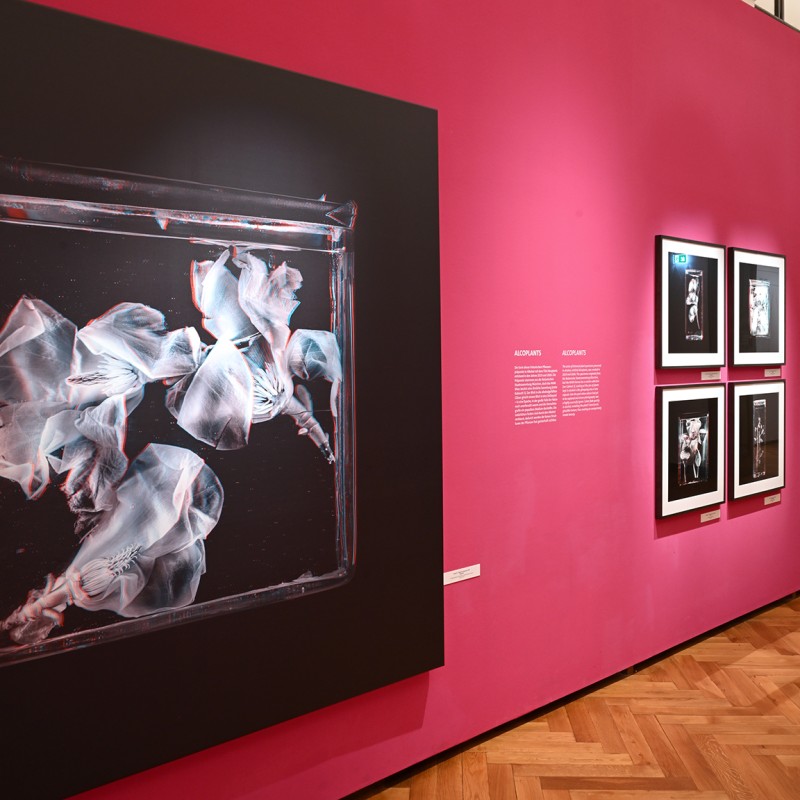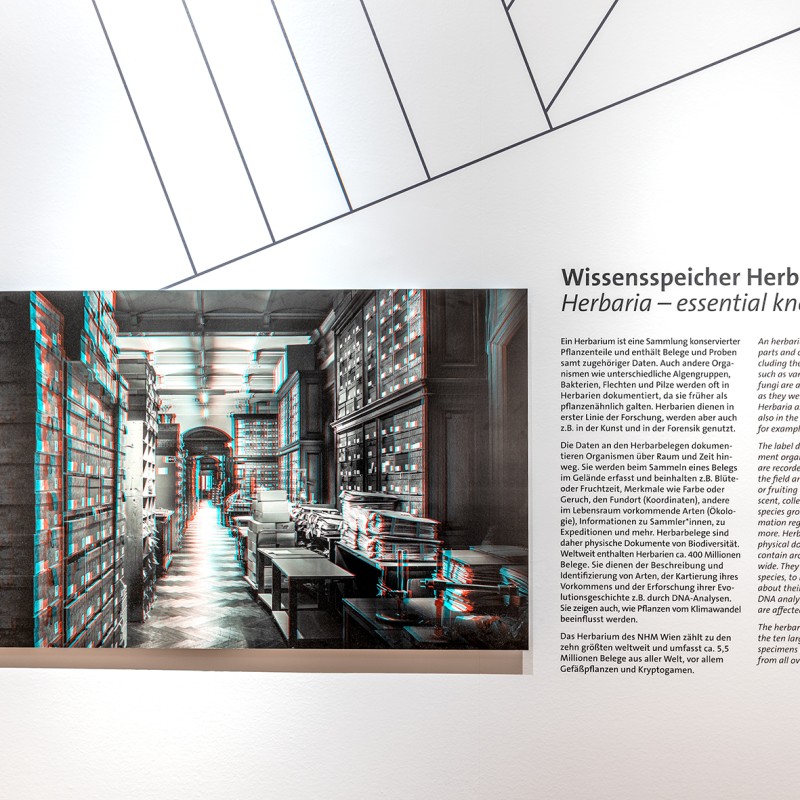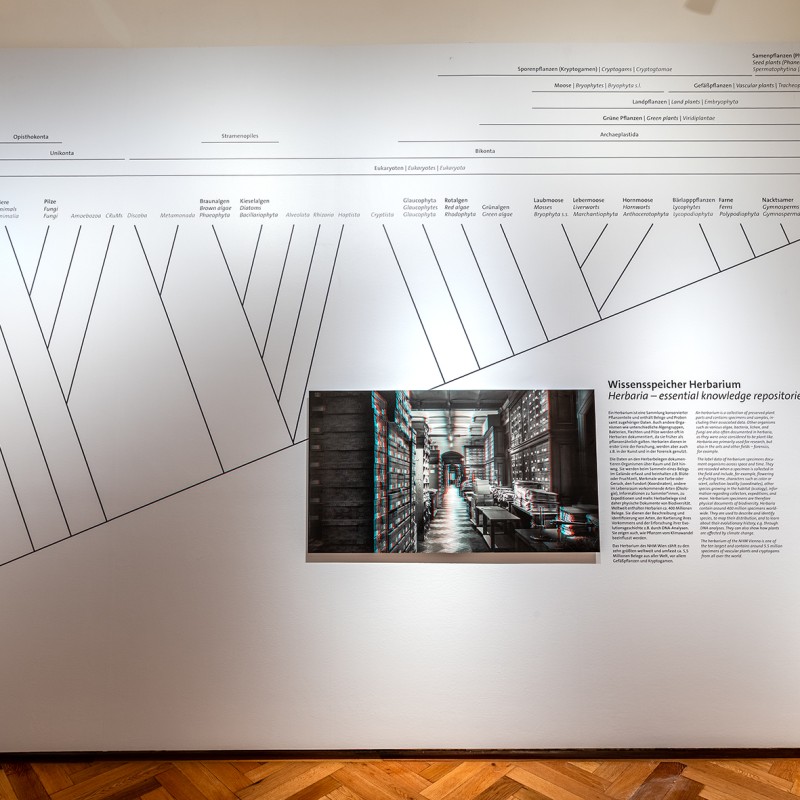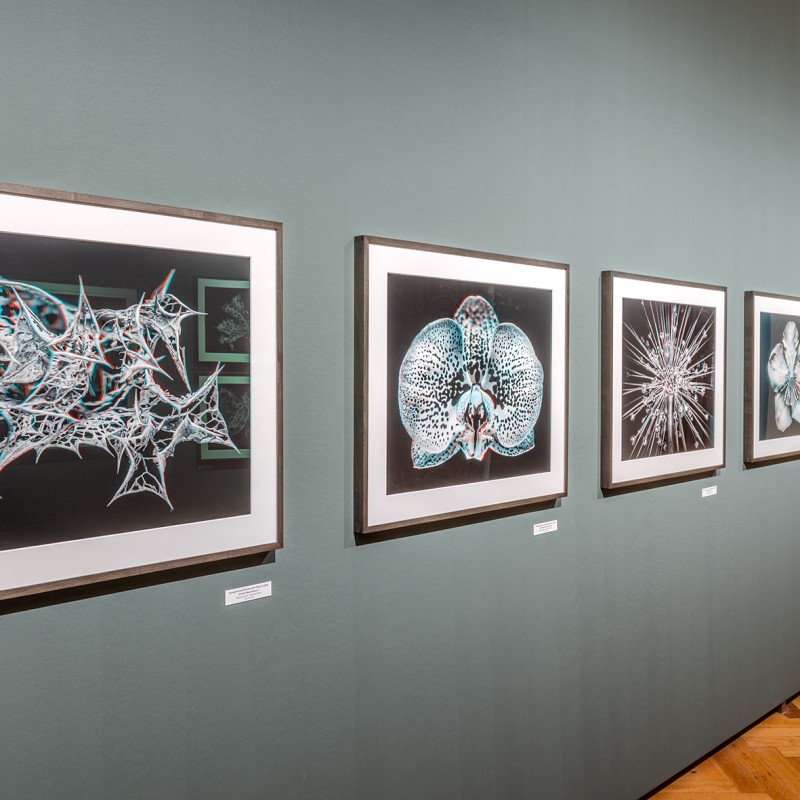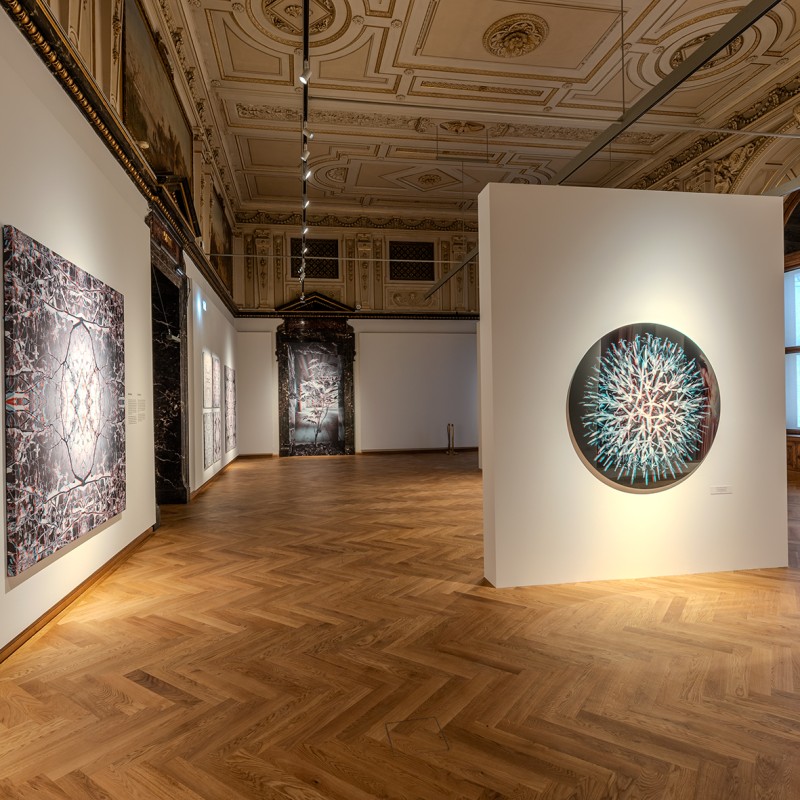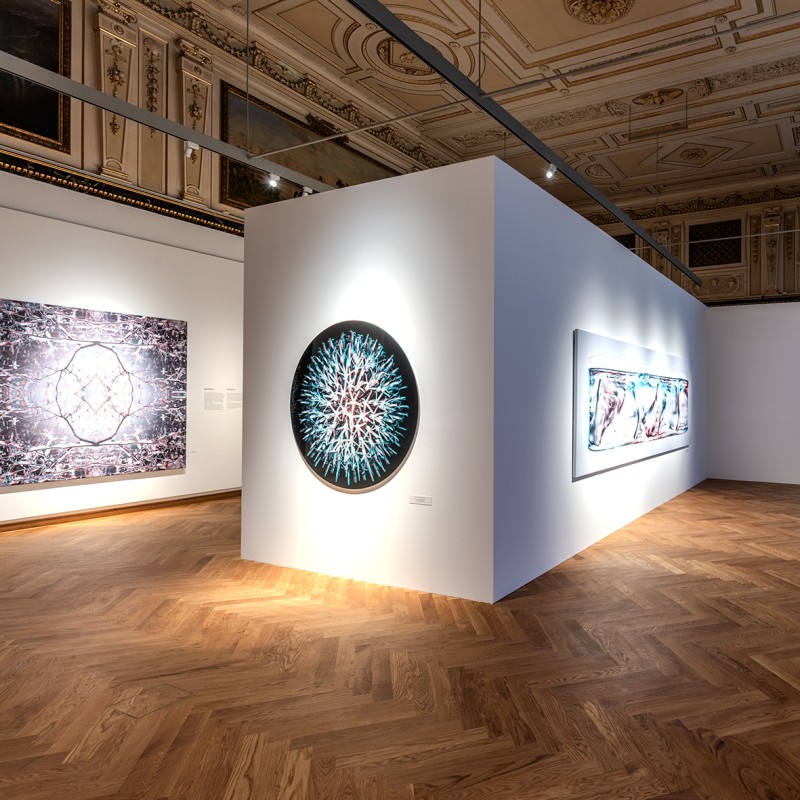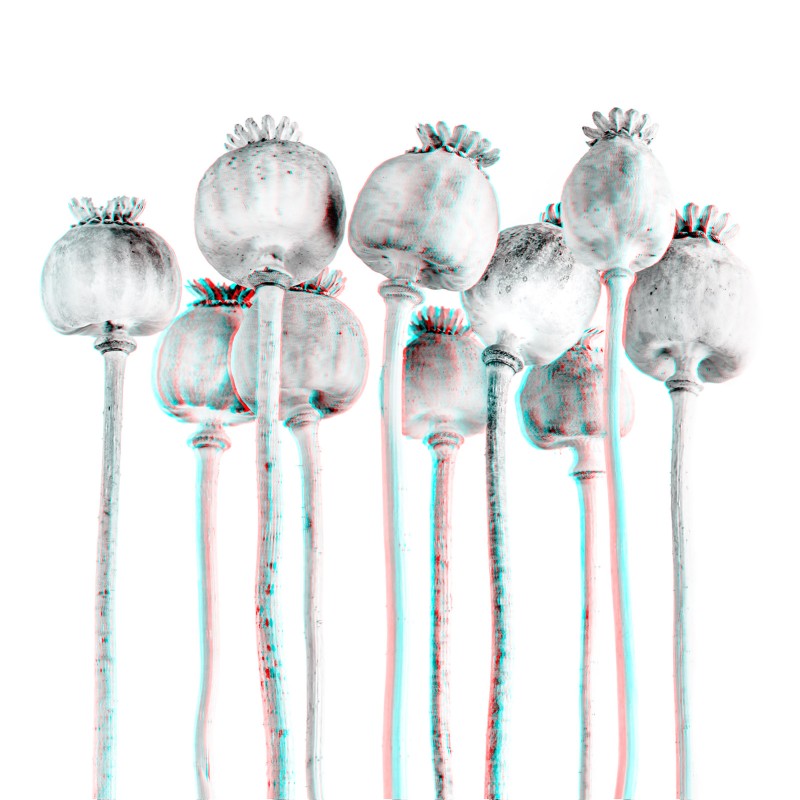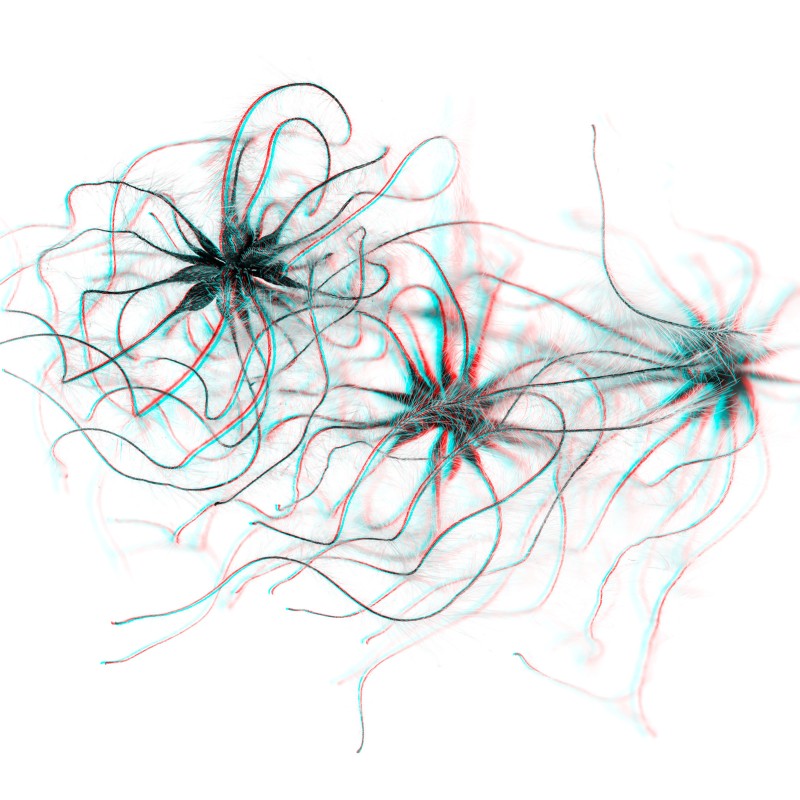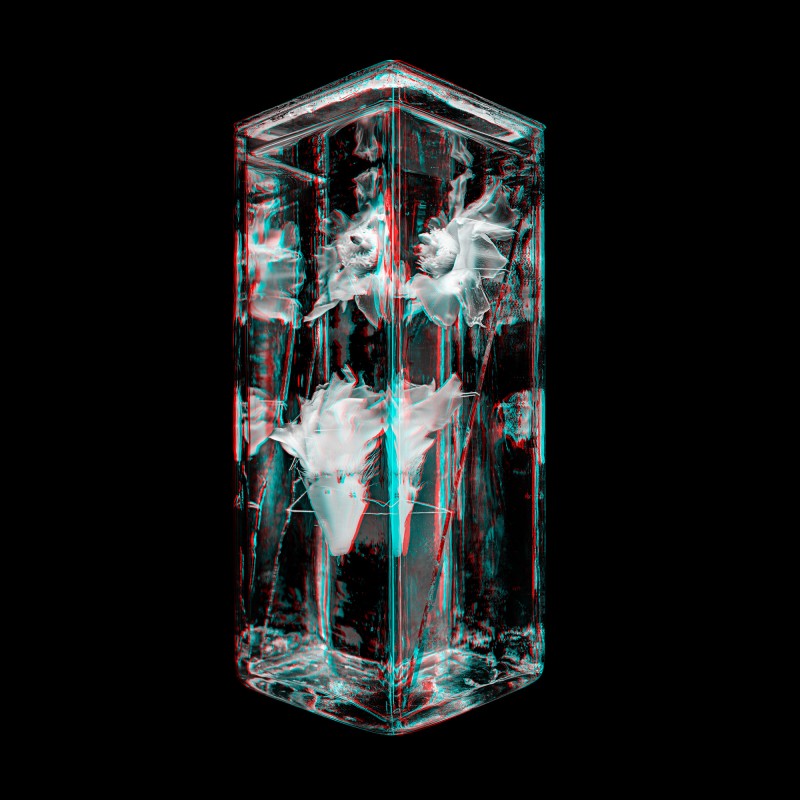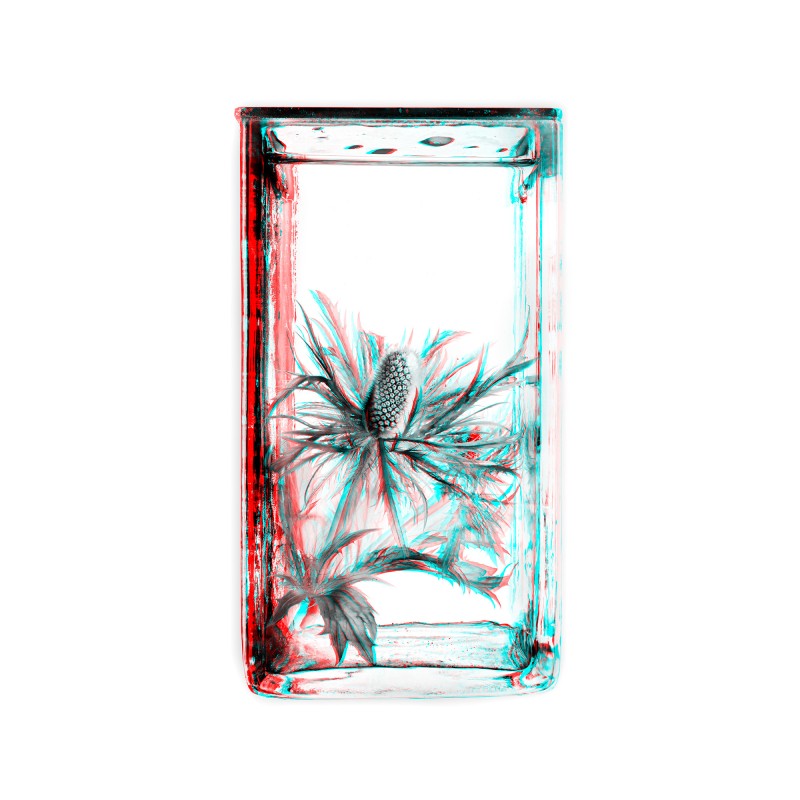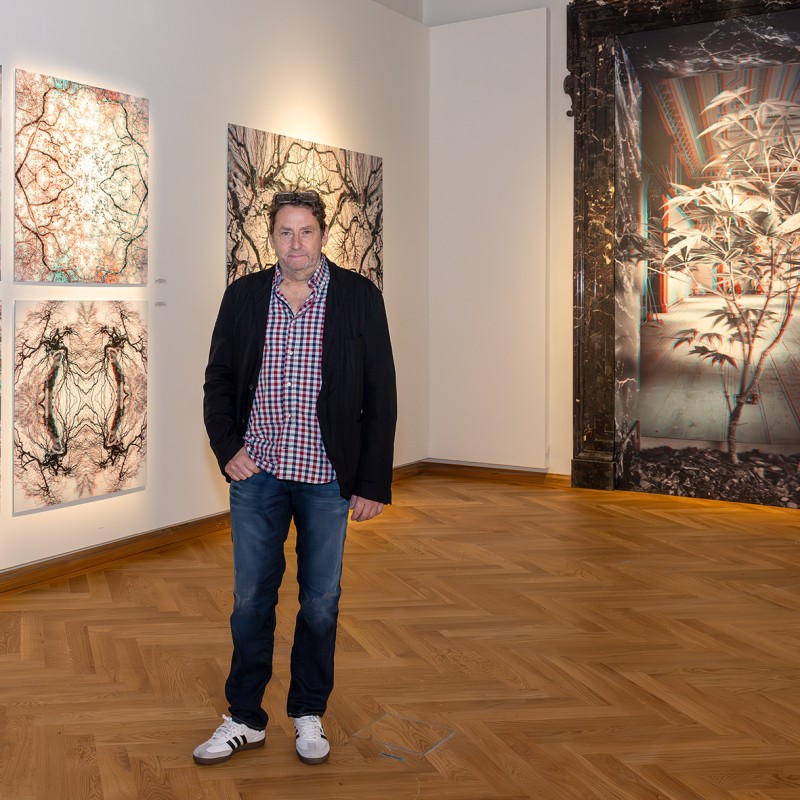Presentation of the new special exhibition: TWO VIEWS ON PLANTS - 3D photography by Sebastian Cramer
23. September 2025
on Tuesday, 23 September 2025, at 10.30 a.m. in the lecture hall of the NHM Vienna
"TWO VIEWS ON PLANTS" is the title of the new exhibition,
which presents 3D photographs by the internationally renowned filmmaker, cinematographer and photographer Sebastian Cramer.
The exhibition presents an innovative form of historical stereoscopic photography, combining image composition and complex
technology. The focus of the project is on plants, which represent the crucial basis of our physical and mental health.
The idea for the project was born in autumn 2016: the wind-blown infructescence of a clematis plant inspired Sebastian Cramer to take a closer look at plants. His observations ultimately gave rise to the book TWO VIEWS ON PLANTS and this presentation, which was compiled exclusively for the NHM Vienna. Both projects involve Sebastian Cramer's contemporary approach to historical stereoscopic photography, which was very popular in the 19th century. In his impressive 3D images, the photographer portrays plant diversity and encourages the viewer to see the world of plants from new perspectives. Some of the 3D photographs also show a special storage method in scientific collections: spirit specimens.
In his work, Sebastian Cramer showcases the beauty of plants and also shows how they are preserved in herbariums, which are scientific collections for plant documentation. The exhibition in the special exhibition rooms on the 1st floor also provides an insight into the diversity of the botanical collection of the NHM Vienna. Boasting an estimated 5.5 million specimens, it is one of the ten largest in the world.
Speakers:
Dr. Katrin Vohland
Director General and Scientific Director, NHM Vienna
Dr. Tanja Schuster
Curator of the exhibition and research assistant of the Botanical Department, NHM Vienna
Sebastian Cramer
photographer
Ilkim Erdost
Head of Education, Vienna Chamber of Labor
The new special exhibition will be on view until 1 March 2026.
We would like to thank the Vienna Chamber of Labor for supporting the exhibition.
Press information
“... This is a rare opportunity to understand
that you have not yet mastered the art of seeing fully,
even if – or especially if – you believe
that this process has long since been completed
and that you have “seen everything already”
...
Never cease being ready to see beauty
and wonder for the first time.”
...
Wim Wenders, from the preface to the book TWO VIEWS ON PLANTS
A focus on plants and their importance
Plants are at the heart of the exhibition TWO VIEWS ON PLANTS. Plants are the basis of life for many other living beings and have a considerable impact on the physical and mental well-being of people. Plants and other organisms that also do photosynthesis can produce their own food: using sunlight as an energy source and the green dye chlorophyll, they produce sugar in a chemical reaction.
Living beings that cannot produce their own food draw the energy to survive from the plants they feed on. Even pure carnivores depend on plants because their prey consumes plants. Another product of photosynthesis is the oxygen we breathe. There is also proof of the positive influence on the human psyche: it has been shown, for example, that we recover faster from stressful situations when we look at plants. Hence, plants significantly influence our physical and mental well-being.
In addition to well-being, oxygen and food, we also rely on plants for fuels, elastomers, building materials, textiles, dyes, medical agents and other chemical compounds. The opium poppy (the poster motif of the exhibition) is one example: as suggested by its name, it contains special active ingredients. The milky sap of the plant contains alkaloids, which are the source of opiates. Opiates are used in medicine as painkillers and narcotics, but are also the basis for the production of illegal drugs such as heroin. Opioids are associated with severe drug addiction, and opioid trafficking is a source of funding for terrorism and wars. On the other hand, surgery and dental treatments without pharmaceutical opium derivatives would be much more traumatic. Every plant portrait in the exhibition contains such contexts and stories.
The Botanical Collection (Herbarium) of the NHM Vienna
Given that this knowledge is essential for our survival, the Botanical Department of the NHM Vienna is working on documenting plants in the herbarium and making them available for research.
With around 5.5 million specimens, it is one of the largest botanical collections in the world. In addition to flowering plants, it contains many specimens of spore plants such as ferns, foliage, liverworts and hornworts, but also other organisms such as algae, lichen and fungi (collective name: cryptogams). The herbarium is rich in historical collections from the 19th and 20th centuries and contains many type documents, which are a kind of ‘birth certificate’ for a scientific plant name. The collection includes plants from all over the world, with a focus on Austrian, Mediterranean and neotropical species. Other important parts of the collections stem from Asia Minor, Australasia and South Africa.
The specimens, mostly pressed and dried parts of plants mounted on strong sheets of paper, shed light on the shape and distinctive features of different species. The data on the labels of the herbarium specimens document organisms across space and time. They are recorded when an item is collected in the field and include, for example, information on flowering or fruiting season, features such as color or smell, the location, other plant species occurring in the habitat, as well as information about collectors, expeditions and more.
Herbarium specimens are therefore physical documents of biodiversity. Worldwide, herbaria contain more than 400 million specimens. They are used to describe and identify species, map their occurrence and research their evolutionary history, e.g. through DNA analyses. They also show how plants are affected by climate change via the information about shifts in flowering times in correlation with climate data. Selected herbarium specimens that can be seen in the exhibition also tell stories of adventurous collection expeditions, the economic and artistic interest in them and how they advance research.
For example, herbarium specimens are now often a source of material for DNA analyses. In this instance, a small part of a leaf is removed and the DNA is isolated and sequenced in the laboratory. Phylogenetic analyses of the DNA sequences yield a phylogenetic tree, a pedigree that graphically illustrates the evolutionary relationships with respect to common ancestors of the analyzed groups. It is important to understand which groups are more closely related compared to others, as this information is useful, for example, to find out which groups contain similar chemical compounds, and hence, medical agents (e.g. for bioprospecting). Such analyses show that fungi are more closely related to animals than to plants. In TWO VIEWS ON PLANTS we show the first phylogenetic pedigree in an exhibition of the NMH Vienna. In the course of the redesign of the permanent showrooms, more of these representations will be on display to illustrate the evolutionary relationships of organisms.
About the exhibition
“I was fascinated by the fact that general design principles had to be challenged when adding
a new aspect to the design: the third dimension. What does a picture have to look like
in order to be equally interesting in 2D and 3D?
Sebastian Cramer
Cooperation between Tanja Schuster with Sebastian Cramer
Sebastian Cramer and Tanja Schuster met at the Botanical Institute in Munich, where the photographer was given access to the collection of liquid specimens from the Herbarium of the Botanical State Collection of Munich. Cramer sees plants as symbols of transience and he is touched by their fragility, while Schuster is interested in their resilience and longevity in terms of evolutionary periods. Something that captivated them both, was their beauty. Cramer and Schuster have subsequently collaborated on the book TWO VIEWS ON PLANTS and continue the cooperation in this exhibition, which was designed exclusively for the NHM Vienna, in order to interest even more people in the topics of botany and stereoscopic photography.
Sebastian Cramer is a photographer, director and cinematographer. He began his career as an editor and director in commercial film before specializing in stereoscopic film projects as from 2009. As a cinematographer, he worked on 3D productions with directors such as Wim Wenders and Michel Comte. For Kraftwerk, the pioneers of electronic music, he shot the Grammy-winning 3D Blu-ray The Catalogue.
Since 2013 he has been dedicating himself to the long-term photographic project TWO VIEWS. The show at the NHM Vienna is the first comprehensive presentation of his work. “My photographs are deliberately hovering on the threshold between documentation and imagination. The clarity of the presentation is reminiscent of botanical studies, of the scientific precision of historical herbarium specimens. But due to the steroscopic effect, what initially appears to be a scientific object becomes a scene, a composition, an event," explains the artist.
The exhibition is dedicated to an almost forgotten form of photography, stereoscopic photography: two slightly different images convey a visual 3D experience that goes far beyond the effect of traditional 2D photography. The combination of stereoscopic technology and botany creates an artistic space that reinterprets questions about nature, perception, memory and the present.
Stereoscopy became popular around 1850 with the invention of the stereoscope by David Brewster and the development of stereoscopic cameras. In the Victorian era, it became a mass medium, but in the 20th century it increasingly took a backseat to new media such as cinema, television and digital imagery.
In the digital age, the illusion of spatial depth is omnipresent – in 3D films, virtual reality worlds and computer simulations. But classical stereoscopy requires a different look, a calm, concentrated act of contemplation. It demands time, attention, an engagement with what seems incidental, which emerges and is silent.
The exhibition will feature Sebastian Cramer’s series of photographs Alcoplants (2019-2020), Mandalas (2017-2023), Zwischen Maschine und Poesie (2024-2025) and the video installation Time Passages (2024-2025).
Alcoplants includes 3D photos of historical liquid preservation of plants in alcohol, as they are available in many scientific collections. This also applies to the Herbarium and other departments of the NHM Vienna. The spirit prevents mold formation and allows the long-term storage of such specimens. The presentation in large glasses was often used in teaching in the 19th century, as this, unlike ‘conventional’ herbarium specimens, preserves the three-dimensionality of the plant and features for species identification are more clearly visible. However, the alcohol destroys the plant color pigments and somewhat breaks down the tissues, which gives them a wobbly, ghostly appearance.
Spirit specimens continue to be used in research, as they facilitate anatomical and morphological studies, but are hardly produced now in this appealing, historical form. Due to their fragility, spirit specimens of plants are rarely on display in museums, and the show at the NHM Vienna is a first time major presentation.
The Alcoplants series was created in 2019 and 2020. The specimens come from the Botanical State Collection Munich, but the NHM Vienna has a similar collection (see Cabinet 3). Looking into the spirit-filled glass vessels is like looking into a time capsule – an era in which large parts of nature were still unexplored and stereoscopic photography was a popular medium.
In the Mandalas series, Sebastian Cramer addresses symmetry, repetition and spatial depth. The images are mirrored along a vertical and a horizontal axis. This creates symmetrical structures reminiscent of classic mandalas. The motifs – flowering branches, finely interwoven twigs, organic patterns – retain their legibility despite the mirroring effect.
With anaglyph 3D glasses, the viewers can experience the images as three-dimensional sculptures and feel the paradoxical sense of space that is created by this technique: the pictorial space appears at the same time real and unreal, physical and ornamental.
The Linescan photographs of the series Between Machine and Poetry depict space, and, above all, the passing of time. In industrial image processing, this technique captures objects in high resolution, e.g. by moving them past a camera on an assembly line. The final image is assembled line by line. ‘It is only movement, only change that gives rise to emerging forms and lets things take shape,’ notes Sebastian Cramer, explaining his intention behind this method.
The video installation Time Passages in the last room of the exhibition represents the calm center. It is closely linked to the photographic series – in particular the Mandalas series and the slit-scan photographs. Time Passages combines these approaches: The camera is not a distanced observer, but part of a space that unfolds anew with each subject. Time is not frozen, but its passing is made visible as a process.
Biographical information:
Sebastian Cramer is a Berlin-born photographer, director and cinematographer for commercials, content productions, documentaries, music videos and feature films. For his work he has received more than thirty international awards.
Cramer has always been driven by the wish to combine image design and complex technical aspects. His invention of the Skater-Mini Dolly was honored with a technical Oscar (Academy Award) and an Emmy Award. In 2009, he founded Screen Plane, a company that develops and distributes stereoscopic film equipment. Screen Plane's technology has already been used in numerous international productions.
As Director of Photography, Cramer has worked on 3D projects for directors such as Wim Wenders and Michel Comte. He also shot the Grammy Award-winning 3D Blu-ray The Catalogue for Kraftwerk, the pioneers of electronic music.
In 2013, Sebastian Cramer initiated the Two Views project – a contemporary evolution of traditional stereoscopic photography. The works of this series will be presented in the first comprehensive show at the NHM Vienna. All works in this exhibition come from the artist's studio collection.
TWO VIEWS
ON PLANTS
SEBASTIAN CRAMER
A STEREOSCOPIC PHOTO BOOK
White Edition and Black Edition in one book
Comes with 2 red/cyan 3D glasses
Wim Wenders – On Beauty and Miracles
Denis Pellerin – The History of Stereo Photography
David Campany in Conversation with Sebastian Cramer
Susanne S. Renner – The Pickled Flower Collection, Munich
Botanical descriptions by Tanja Schuster, Stefan Dressler, Birgit Kanz, Christian Printzen
@2022, Hatje Cantz Verlag, Berlin
ISBN 978-3-7757-5382-1
Available for € 46,- in the shop of NHM Vienna.
Contact the artist:
Sebastian Cramer
info@sebastiancramer.com
https://sebastiancramer.com/
@studiosebastiancramer
Scientific contact:
Dr. Tanja Schuster, Research Associate, Curator for Kryptogamen,
Botanical Department, NHM Vienna
https://www.nhm.at/tanja_schuster
Telephone: +43 1 52177-248 I tanja.schuster@nhm.at
Press material for download: https://www.nhm.at/presse/pressemitteilungen2025/twoviews
General request for information:
Mag. Irina Kubadinov, Head of Press Department, Press Spokesperson
https://www.nhm.at/irina_kubadinow
Tel.: + 43 (1) 521 77 – 410 | irina.kubadinow@nhm.at
Accompanying programme to the special exhibition:
programme
Wed, 24 September 2025, 5 p.m. | Guided tour
TWO VIEWS on Plants – how an exhibition is created
Julia Landsiedl and Tanja Schuster (NHM Vienna)
Why are plants so important, what is a herbarium and how to educate people about such a collection? The tour is a stroll through the beautiful ‘TWO VIEWS ON PLANTS’ exhibition with 3D photos by artist Sebastian Cramer. The scenographer Julia Landsiedl and the scientific curator Tanja Schuster show how an exhibition is born.
Wed, January 14, 2026, 6.30 p.m.
Stereoscopy – forgotten photography
Sebastian Cramer (photographer)
A lecture on space, three dimensions and the relationship between photography and perception. Why do we see in 3D, and why are plants ideal motifs for this technique? In tandem with the exhibition TWO VIEWS ON PLANTS, the aim of this presentation is to rediscover stereoscopy – not as a technical gimmick, but as an independent photographic form with poetic potential.
Wed, 21 January 2026, 6.30 p.m. Behind the Scenes
The Herbarium of NHM Vienna
Tanja Schuster (NHM Vienna)
Plants are the focus of the exhibition. This tour outside the exhibition area gives an insight into how and why they are documented in natural history museums. How are plants preserved in a herbarium, what kind of research are they subjected to and where are they used (e.g. in art, agriculture and forensics)?
Sun, 25 January 2026, 09.00 a.m. | Poetic breakfast
Ode to photosynthesis
Brigitta Schmid (NHM Vienna)
Green plants impress us not only by dint of their diversity and beauty. With their ability to photosynthesize, they are also the indispensable basis for all life on our earth. Their sedentary way of life also makes them one of the most vulnerable components of any ecosystem – a wide field of poetic interpretations.
Wed, February 11, 2026, 6.30 p.m.
On the sunny side of life
Tanja Schuster (NHM Vienna)
Most of the 3D photos in the exhibition show flowering plants. The lecture discusses their essential role for humans: e.g. as food, medicine, suppliers of mind-altering substances and as oxygen producers. Plants use sunlight as an energy source, which means they stand on the sunny side of life.
Wed, February 25, 2026, 5 p.m.
TWO VIEWS on Plants – how an exhibition is created
Julia Landsiedl and Tanja Schuster (NHM Vienna)
Why are plants so important, what is a herbarium and how to educate people about such a collection? The tour is a stroll through the beautiful ‘TWO VIEWS ON PLANTS’ exhibition with 3D photos by artist Sebastian Cramer. The scenographer Julia Landsiedl and the scientific curator Tanja Schuster show how an exhibition is born.
The idea for the project was born in autumn 2016: the wind-blown infructescence of a clematis plant inspired Sebastian Cramer to take a closer look at plants. His observations ultimately gave rise to the book TWO VIEWS ON PLANTS and this presentation, which was compiled exclusively for the NHM Vienna. Both projects involve Sebastian Cramer's contemporary approach to historical stereoscopic photography, which was very popular in the 19th century. In his impressive 3D images, the photographer portrays plant diversity and encourages the viewer to see the world of plants from new perspectives. Some of the 3D photographs also show a special storage method in scientific collections: spirit specimens.
In his work, Sebastian Cramer showcases the beauty of plants and also shows how they are preserved in herbariums, which are scientific collections for plant documentation. The exhibition in the special exhibition rooms on the 1st floor also provides an insight into the diversity of the botanical collection of the NHM Vienna. Boasting an estimated 5.5 million specimens, it is one of the ten largest in the world.
Speakers:
Dr. Katrin Vohland
Director General and Scientific Director, NHM Vienna
Dr. Tanja Schuster
Curator of the exhibition and research assistant of the Botanical Department, NHM Vienna
Sebastian Cramer
photographer
Ilkim Erdost
Head of Education, Vienna Chamber of Labor
The new special exhibition will be on view until 1 March 2026.
We would like to thank the Vienna Chamber of Labor for supporting the exhibition.
Press information
“... This is a rare opportunity to understand
that you have not yet mastered the art of seeing fully,
even if – or especially if – you believe
that this process has long since been completed
and that you have “seen everything already”
...
Never cease being ready to see beauty
and wonder for the first time.”
...
Wim Wenders, from the preface to the book TWO VIEWS ON PLANTS
A focus on plants and their importance
Plants are at the heart of the exhibition TWO VIEWS ON PLANTS. Plants are the basis of life for many other living beings and have a considerable impact on the physical and mental well-being of people. Plants and other organisms that also do photosynthesis can produce their own food: using sunlight as an energy source and the green dye chlorophyll, they produce sugar in a chemical reaction.
Living beings that cannot produce their own food draw the energy to survive from the plants they feed on. Even pure carnivores depend on plants because their prey consumes plants. Another product of photosynthesis is the oxygen we breathe. There is also proof of the positive influence on the human psyche: it has been shown, for example, that we recover faster from stressful situations when we look at plants. Hence, plants significantly influence our physical and mental well-being.
In addition to well-being, oxygen and food, we also rely on plants for fuels, elastomers, building materials, textiles, dyes, medical agents and other chemical compounds. The opium poppy (the poster motif of the exhibition) is one example: as suggested by its name, it contains special active ingredients. The milky sap of the plant contains alkaloids, which are the source of opiates. Opiates are used in medicine as painkillers and narcotics, but are also the basis for the production of illegal drugs such as heroin. Opioids are associated with severe drug addiction, and opioid trafficking is a source of funding for terrorism and wars. On the other hand, surgery and dental treatments without pharmaceutical opium derivatives would be much more traumatic. Every plant portrait in the exhibition contains such contexts and stories.
The Botanical Collection (Herbarium) of the NHM Vienna
Given that this knowledge is essential for our survival, the Botanical Department of the NHM Vienna is working on documenting plants in the herbarium and making them available for research.
With around 5.5 million specimens, it is one of the largest botanical collections in the world. In addition to flowering plants, it contains many specimens of spore plants such as ferns, foliage, liverworts and hornworts, but also other organisms such as algae, lichen and fungi (collective name: cryptogams). The herbarium is rich in historical collections from the 19th and 20th centuries and contains many type documents, which are a kind of ‘birth certificate’ for a scientific plant name. The collection includes plants from all over the world, with a focus on Austrian, Mediterranean and neotropical species. Other important parts of the collections stem from Asia Minor, Australasia and South Africa.
The specimens, mostly pressed and dried parts of plants mounted on strong sheets of paper, shed light on the shape and distinctive features of different species. The data on the labels of the herbarium specimens document organisms across space and time. They are recorded when an item is collected in the field and include, for example, information on flowering or fruiting season, features such as color or smell, the location, other plant species occurring in the habitat, as well as information about collectors, expeditions and more.
Herbarium specimens are therefore physical documents of biodiversity. Worldwide, herbaria contain more than 400 million specimens. They are used to describe and identify species, map their occurrence and research their evolutionary history, e.g. through DNA analyses. They also show how plants are affected by climate change via the information about shifts in flowering times in correlation with climate data. Selected herbarium specimens that can be seen in the exhibition also tell stories of adventurous collection expeditions, the economic and artistic interest in them and how they advance research.
For example, herbarium specimens are now often a source of material for DNA analyses. In this instance, a small part of a leaf is removed and the DNA is isolated and sequenced in the laboratory. Phylogenetic analyses of the DNA sequences yield a phylogenetic tree, a pedigree that graphically illustrates the evolutionary relationships with respect to common ancestors of the analyzed groups. It is important to understand which groups are more closely related compared to others, as this information is useful, for example, to find out which groups contain similar chemical compounds, and hence, medical agents (e.g. for bioprospecting). Such analyses show that fungi are more closely related to animals than to plants. In TWO VIEWS ON PLANTS we show the first phylogenetic pedigree in an exhibition of the NMH Vienna. In the course of the redesign of the permanent showrooms, more of these representations will be on display to illustrate the evolutionary relationships of organisms.
About the exhibition
“I was fascinated by the fact that general design principles had to be challenged when adding
a new aspect to the design: the third dimension. What does a picture have to look like
in order to be equally interesting in 2D and 3D?
Sebastian Cramer
Cooperation between Tanja Schuster with Sebastian Cramer
Sebastian Cramer and Tanja Schuster met at the Botanical Institute in Munich, where the photographer was given access to the collection of liquid specimens from the Herbarium of the Botanical State Collection of Munich. Cramer sees plants as symbols of transience and he is touched by their fragility, while Schuster is interested in their resilience and longevity in terms of evolutionary periods. Something that captivated them both, was their beauty. Cramer and Schuster have subsequently collaborated on the book TWO VIEWS ON PLANTS and continue the cooperation in this exhibition, which was designed exclusively for the NHM Vienna, in order to interest even more people in the topics of botany and stereoscopic photography.
Sebastian Cramer is a photographer, director and cinematographer. He began his career as an editor and director in commercial film before specializing in stereoscopic film projects as from 2009. As a cinematographer, he worked on 3D productions with directors such as Wim Wenders and Michel Comte. For Kraftwerk, the pioneers of electronic music, he shot the Grammy-winning 3D Blu-ray The Catalogue.
Since 2013 he has been dedicating himself to the long-term photographic project TWO VIEWS. The show at the NHM Vienna is the first comprehensive presentation of his work. “My photographs are deliberately hovering on the threshold between documentation and imagination. The clarity of the presentation is reminiscent of botanical studies, of the scientific precision of historical herbarium specimens. But due to the steroscopic effect, what initially appears to be a scientific object becomes a scene, a composition, an event," explains the artist.
The exhibition is dedicated to an almost forgotten form of photography, stereoscopic photography: two slightly different images convey a visual 3D experience that goes far beyond the effect of traditional 2D photography. The combination of stereoscopic technology and botany creates an artistic space that reinterprets questions about nature, perception, memory and the present.
Stereoscopy became popular around 1850 with the invention of the stereoscope by David Brewster and the development of stereoscopic cameras. In the Victorian era, it became a mass medium, but in the 20th century it increasingly took a backseat to new media such as cinema, television and digital imagery.
In the digital age, the illusion of spatial depth is omnipresent – in 3D films, virtual reality worlds and computer simulations. But classical stereoscopy requires a different look, a calm, concentrated act of contemplation. It demands time, attention, an engagement with what seems incidental, which emerges and is silent.
The exhibition will feature Sebastian Cramer’s series of photographs Alcoplants (2019-2020), Mandalas (2017-2023), Zwischen Maschine und Poesie (2024-2025) and the video installation Time Passages (2024-2025).
Alcoplants includes 3D photos of historical liquid preservation of plants in alcohol, as they are available in many scientific collections. This also applies to the Herbarium and other departments of the NHM Vienna. The spirit prevents mold formation and allows the long-term storage of such specimens. The presentation in large glasses was often used in teaching in the 19th century, as this, unlike ‘conventional’ herbarium specimens, preserves the three-dimensionality of the plant and features for species identification are more clearly visible. However, the alcohol destroys the plant color pigments and somewhat breaks down the tissues, which gives them a wobbly, ghostly appearance.
Spirit specimens continue to be used in research, as they facilitate anatomical and morphological studies, but are hardly produced now in this appealing, historical form. Due to their fragility, spirit specimens of plants are rarely on display in museums, and the show at the NHM Vienna is a first time major presentation.
The Alcoplants series was created in 2019 and 2020. The specimens come from the Botanical State Collection Munich, but the NHM Vienna has a similar collection (see Cabinet 3). Looking into the spirit-filled glass vessels is like looking into a time capsule – an era in which large parts of nature were still unexplored and stereoscopic photography was a popular medium.
In the Mandalas series, Sebastian Cramer addresses symmetry, repetition and spatial depth. The images are mirrored along a vertical and a horizontal axis. This creates symmetrical structures reminiscent of classic mandalas. The motifs – flowering branches, finely interwoven twigs, organic patterns – retain their legibility despite the mirroring effect.
With anaglyph 3D glasses, the viewers can experience the images as three-dimensional sculptures and feel the paradoxical sense of space that is created by this technique: the pictorial space appears at the same time real and unreal, physical and ornamental.
The Linescan photographs of the series Between Machine and Poetry depict space, and, above all, the passing of time. In industrial image processing, this technique captures objects in high resolution, e.g. by moving them past a camera on an assembly line. The final image is assembled line by line. ‘It is only movement, only change that gives rise to emerging forms and lets things take shape,’ notes Sebastian Cramer, explaining his intention behind this method.
The video installation Time Passages in the last room of the exhibition represents the calm center. It is closely linked to the photographic series – in particular the Mandalas series and the slit-scan photographs. Time Passages combines these approaches: The camera is not a distanced observer, but part of a space that unfolds anew with each subject. Time is not frozen, but its passing is made visible as a process.
Biographical information:
Sebastian Cramer is a Berlin-born photographer, director and cinematographer for commercials, content productions, documentaries, music videos and feature films. For his work he has received more than thirty international awards.
Cramer has always been driven by the wish to combine image design and complex technical aspects. His invention of the Skater-Mini Dolly was honored with a technical Oscar (Academy Award) and an Emmy Award. In 2009, he founded Screen Plane, a company that develops and distributes stereoscopic film equipment. Screen Plane's technology has already been used in numerous international productions.
As Director of Photography, Cramer has worked on 3D projects for directors such as Wim Wenders and Michel Comte. He also shot the Grammy Award-winning 3D Blu-ray The Catalogue for Kraftwerk, the pioneers of electronic music.
In 2013, Sebastian Cramer initiated the Two Views project – a contemporary evolution of traditional stereoscopic photography. The works of this series will be presented in the first comprehensive show at the NHM Vienna. All works in this exhibition come from the artist's studio collection.
TWO VIEWS
ON PLANTS
SEBASTIAN CRAMER
A STEREOSCOPIC PHOTO BOOK
White Edition and Black Edition in one book
Comes with 2 red/cyan 3D glasses
Wim Wenders – On Beauty and Miracles
Denis Pellerin – The History of Stereo Photography
David Campany in Conversation with Sebastian Cramer
Susanne S. Renner – The Pickled Flower Collection, Munich
Botanical descriptions by Tanja Schuster, Stefan Dressler, Birgit Kanz, Christian Printzen
@2022, Hatje Cantz Verlag, Berlin
ISBN 978-3-7757-5382-1
Available for € 46,- in the shop of NHM Vienna.
Contact the artist:
Sebastian Cramer
info@sebastiancramer.com
https://sebastiancramer.com/
@studiosebastiancramer
Scientific contact:
Dr. Tanja Schuster, Research Associate, Curator for Kryptogamen,
Botanical Department, NHM Vienna
https://www.nhm.at/tanja_schuster
Telephone: +43 1 52177-248 I tanja.schuster@nhm.at
Press material for download: https://www.nhm.at/presse/pressemitteilungen2025/twoviews
General request for information:
Mag. Irina Kubadinov, Head of Press Department, Press Spokesperson
https://www.nhm.at/irina_kubadinow
Tel.: + 43 (1) 521 77 – 410 | irina.kubadinow@nhm.at
Accompanying programme to the special exhibition:
programme
Wed, 24 September 2025, 5 p.m. | Guided tour
TWO VIEWS on Plants – how an exhibition is created
Julia Landsiedl and Tanja Schuster (NHM Vienna)
Why are plants so important, what is a herbarium and how to educate people about such a collection? The tour is a stroll through the beautiful ‘TWO VIEWS ON PLANTS’ exhibition with 3D photos by artist Sebastian Cramer. The scenographer Julia Landsiedl and the scientific curator Tanja Schuster show how an exhibition is born.
Wed, January 14, 2026, 6.30 p.m.
Stereoscopy – forgotten photography
Sebastian Cramer (photographer)
A lecture on space, three dimensions and the relationship between photography and perception. Why do we see in 3D, and why are plants ideal motifs for this technique? In tandem with the exhibition TWO VIEWS ON PLANTS, the aim of this presentation is to rediscover stereoscopy – not as a technical gimmick, but as an independent photographic form with poetic potential.
Wed, 21 January 2026, 6.30 p.m. Behind the Scenes
The Herbarium of NHM Vienna
Tanja Schuster (NHM Vienna)
Plants are the focus of the exhibition. This tour outside the exhibition area gives an insight into how and why they are documented in natural history museums. How are plants preserved in a herbarium, what kind of research are they subjected to and where are they used (e.g. in art, agriculture and forensics)?
Sun, 25 January 2026, 09.00 a.m. | Poetic breakfast
Ode to photosynthesis
Brigitta Schmid (NHM Vienna)
Green plants impress us not only by dint of their diversity and beauty. With their ability to photosynthesize, they are also the indispensable basis for all life on our earth. Their sedentary way of life also makes them one of the most vulnerable components of any ecosystem – a wide field of poetic interpretations.
Wed, February 11, 2026, 6.30 p.m.
On the sunny side of life
Tanja Schuster (NHM Vienna)
Most of the 3D photos in the exhibition show flowering plants. The lecture discusses their essential role for humans: e.g. as food, medicine, suppliers of mind-altering substances and as oxygen producers. Plants use sunlight as an energy source, which means they stand on the sunny side of life.
Wed, February 25, 2026, 5 p.m.
TWO VIEWS on Plants – how an exhibition is created
Julia Landsiedl and Tanja Schuster (NHM Vienna)
Why are plants so important, what is a herbarium and how to educate people about such a collection? The tour is a stroll through the beautiful ‘TWO VIEWS ON PLANTS’ exhibition with 3D photos by artist Sebastian Cramer. The scenographer Julia Landsiedl and the scientific curator Tanja Schuster show how an exhibition is born.

